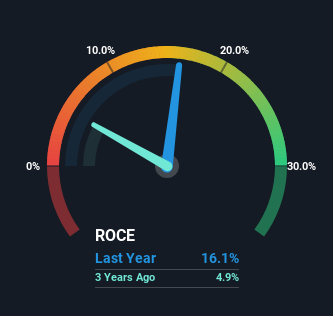- South Korea
- /
- Household Products
- /
- KOSE:A018250
Capital Allocation Trends At Aekyung Industrial (KRX:018250) Aren't Ideal

What financial metrics can indicate to us that a company is maturing or even in decline? A business that's potentially in decline often shows two trends, a return on capital employed (ROCE) that's declining, and a base of capital employed that's also declining. Ultimately this means that the company is earning less per dollar invested and on top of that, it's shrinking its base of capital employed. On that note, looking into Aekyung Industrial (KRX:018250), we weren't too upbeat about how things were going.
Understanding Return On Capital Employed (ROCE)
If you haven't worked with ROCE before, it measures the 'return' (pre-tax profit) a company generates from capital employed in its business. Analysts use this formula to calculate it for Aekyung Industrial:
Return on Capital Employed = Earnings Before Interest and Tax (EBIT) ÷ (Total Assets - Current Liabilities)
0.16 = ₩63b ÷ (₩500b - ₩110b) (Based on the trailing twelve months to March 2024).
So, Aekyung Industrial has an ROCE of 16%. In absolute terms, that's a satisfactory return, but compared to the Household Products industry average of 8.7% it's much better.
See our latest analysis for Aekyung Industrial

Above you can see how the current ROCE for Aekyung Industrial compares to its prior returns on capital, but there's only so much you can tell from the past. If you'd like, you can check out the forecasts from the analysts covering Aekyung Industrial for free.
What Can We Tell From Aekyung Industrial's ROCE Trend?
There is reason to be cautious about Aekyung Industrial, given the returns are trending downwards. About five years ago, returns on capital were 24%, however they're now substantially lower than that as we saw above. On top of that, it's worth noting that the amount of capital employed within the business has remained relatively steady. This combination can be indicative of a mature business that still has areas to deploy capital, but the returns received aren't as high due potentially to new competition or smaller margins. If these trends continue, we wouldn't expect Aekyung Industrial to turn into a multi-bagger.
The Bottom Line
In summary, it's unfortunate that Aekyung Industrial is generating lower returns from the same amount of capital. Long term shareholders who've owned the stock over the last five years have experienced a 29% depreciation in their investment, so it appears the market might not like these trends either. With underlying trends that aren't great in these areas, we'd consider looking elsewhere.
Like most companies, Aekyung Industrial does come with some risks, and we've found 1 warning sign that you should be aware of.
For those who like to invest in solid companies, check out this free list of companies with solid balance sheets and high returns on equity.
New: Manage All Your Stock Portfolios in One Place
We've created the ultimate portfolio companion for stock investors, and it's free.
• Connect an unlimited number of Portfolios and see your total in one currency
• Be alerted to new Warning Signs or Risks via email or mobile
• Track the Fair Value of your stocks
Have feedback on this article? Concerned about the content? Get in touch with us directly. Alternatively, email editorial-team (at) simplywallst.com.
This article by Simply Wall St is general in nature. We provide commentary based on historical data and analyst forecasts only using an unbiased methodology and our articles are not intended to be financial advice. It does not constitute a recommendation to buy or sell any stock, and does not take account of your objectives, or your financial situation. We aim to bring you long-term focused analysis driven by fundamental data. Note that our analysis may not factor in the latest price-sensitive company announcements or qualitative material. Simply Wall St has no position in any stocks mentioned.
Have feedback on this article? Concerned about the content? Get in touch with us directly. Alternatively, email editorial-team@simplywallst.com
About KOSE:A018250
Aekyung Industrial
Engages in the manufacture and sale of household products in South Korea.
Flawless balance sheet and good value.
Market Insights
Community Narratives



